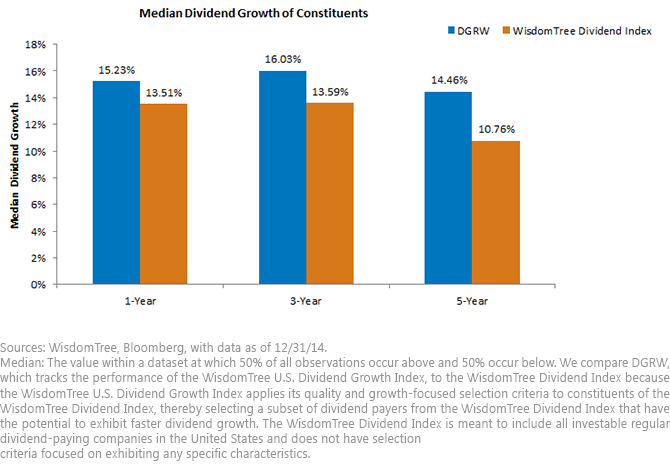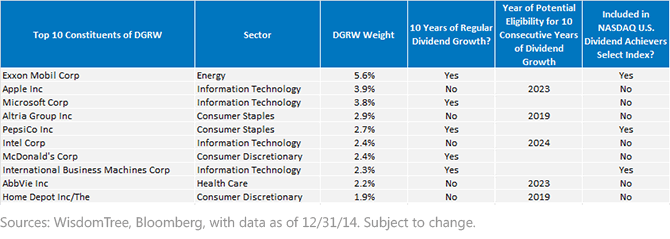Will You Capture Apple's Growth in Your Dividend ETF Before 2023?


 For current holdings of the WisdomTree Dividend Index, click here.
Apple’s strong gains and future dividend growth potential raise the question, “Is my dividend ETF designed to capture today’s (and tomorrow’s) dividend payers, or are these new technology companies going to be missing for a very long time?” We see below that Apple was the second largest exposure in DGRW as of December 31, 2014.
Do you really want to wait until 2023 to hold Apple in your dividend ETF?
For current holdings of the WisdomTree Dividend Index, click here.
Apple’s strong gains and future dividend growth potential raise the question, “Is my dividend ETF designed to capture today’s (and tomorrow’s) dividend payers, or are these new technology companies going to be missing for a very long time?” We see below that Apple was the second largest exposure in DGRW as of December 31, 2014.
Do you really want to wait until 2023 to hold Apple in your dividend ETF?
 For current holdings of the WisdomTree U.S. Dividend Growth Fund (DGRW), click here.
1Source: “Apple Reports Record First Quarter Results,” Apple Press Info, 1/27/15.
2Source: “Apple Posts the Biggest Quarterly Profit in History,” BBC News Business, 1/28/15.
3Source: “Apple Posts the Biggest Quarterly Profit in History,” BBC News Business, 1/28/15.
4Source: “Apple Reports Record First Quarter Results,” Apple Press Info, 1/27/18.
5Source: Bloomberg. On February 13, 1996, Apple canceled its quarterly dividend.
6Source: Bloomberg.
7Source: Bloomberg, with last four ex-dividend dates being 5/8/14, 8/7/14, 11/6/14 and 2/5/15.
8Source: Bloomberg, with ex-dates from 2/6/14 to 5/8/14 being measured.
9Source: Bloomberg, measured as of WisdomTree’s 11/30/14 Index screening.
For current holdings of the WisdomTree U.S. Dividend Growth Fund (DGRW), click here.
1Source: “Apple Reports Record First Quarter Results,” Apple Press Info, 1/27/15.
2Source: “Apple Posts the Biggest Quarterly Profit in History,” BBC News Business, 1/28/15.
3Source: “Apple Posts the Biggest Quarterly Profit in History,” BBC News Business, 1/28/15.
4Source: “Apple Reports Record First Quarter Results,” Apple Press Info, 1/27/18.
5Source: Bloomberg. On February 13, 1996, Apple canceled its quarterly dividend.
6Source: Bloomberg.
7Source: Bloomberg, with last four ex-dividend dates being 5/8/14, 8/7/14, 11/6/14 and 2/5/15.
8Source: Bloomberg, with ex-dates from 2/6/14 to 5/8/14 being measured.
9Source: Bloomberg, measured as of WisdomTree’s 11/30/14 Index screening.
Important Risks Related to this Article
Dividends are not guaranteed, and a company’s future ability to pay dividends may be limited. A company currently paying dividends may cease paying dividends at any time. There are risks associated with investing, including possible loss of principal. Funds focusing their investments on certain sectors increase their vulnerability to any single economic or regulatory development. This may result in greater share price volatility. Please read the Fund’s prospectus for specific details regarding the Fund’s risk profile.

Jeremy Schwartz has served as our Global Chief Investment Officer since November 2021 and leads WisdomTree’s investment strategy team in the construction of WisdomTree’s equity Indexes, quantitative active strategies and multi-asset Model Portfolios. Jeremy joined WisdomTree in May 2005 as a Senior Analyst, adding Deputy Director of Research to his responsibilities in February 2007. He served as Director of Research from October 2008 to October 2018 and as Global Head of Research from November 2018 to November 2021. Before joining WisdomTree, he was a head research assistant for Professor Jeremy Siegel and, in 2022, became his co-author on the sixth edition of the book Stocks for the Long Run. Jeremy is also co-author of the Financial Analysts Journal paper “What Happened to the Original Stocks in the S&P 500?” He received his B.S. in economics from The Wharton School of the University of Pennsylvania and hosts the Wharton Business Radio program Behind the Markets on SiriusXM 132. Jeremy is a member of the CFA Society of Philadelphia.

